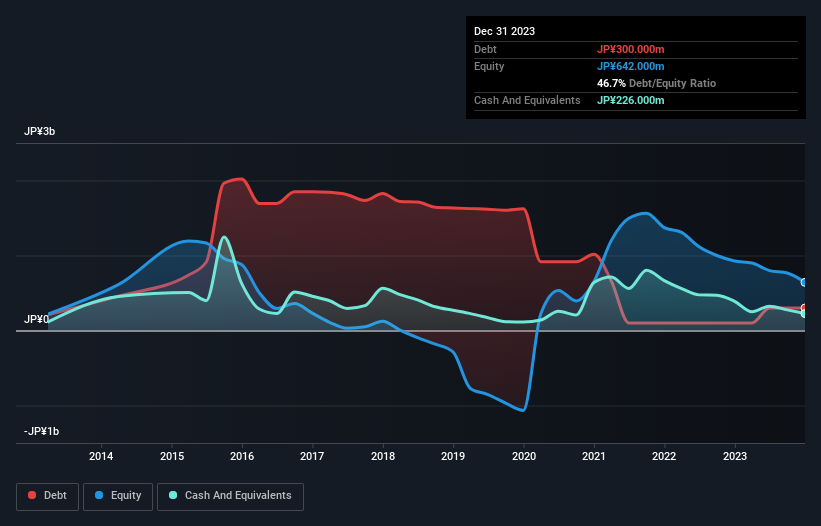
Legendary fund manager Li Lu (who Charlie Munger backed) once said, 'The biggest investment risk is not the volatility of prices, but whether you will suffer a permanent loss of capital.' So it might be obvious that you need to consider debt, when you think about how risky any given stock is, because too much debt can sink a company. We note that Fruta Fruta Inc. (TSE:2586) does have debt on its balance sheet. But the more important question is: how much risk is that debt creating?
Why Does Debt Bring Risk?
Debt assists a business until the business has trouble paying it off, either with new capital or with free cash flow. If things get really bad, the lenders can take control of the business. However, a more common (but still painful) scenario is that it has to raise new equity capital at a low price, thus permanently diluting shareholders. Of course, plenty of companies use debt to fund growth, without any negative consequences. When we think about a company's use of debt, we first look at cash and debt together.
View our latest analysis for Fruta Fruta
How Much Debt Does Fruta Fruta Carry?
As you can see below, at the end of December 2023, Fruta Fruta had JP¥300.0m of debt, up from JP¥100.0m a year ago. Click the image for more detail. On the flip side, it has JP¥226.0m in cash leading to net debt of about JP¥74.0m.

How Healthy Is Fruta Fruta's Balance Sheet?
The latest balance sheet data shows that Fruta Fruta had liabilities of JP¥214.0m due within a year, and liabilities of JP¥303.0m falling due after that. Offsetting these obligations, it had cash of JP¥226.0m as well as receivables valued at JP¥136.0m due within 12 months. So it has liabilities totalling JP¥155.0m more than its cash and near-term receivables, combined.
Of course, Fruta Fruta has a market capitalization of JP¥1.55b, so these liabilities are probably manageable. Having said that, it's clear that we should continue to monitor its balance sheet, lest it change for the worse. The balance sheet is clearly the area to focus on when you are analysing debt. But you can't view debt in total isolation; since Fruta Fruta will need earnings to service that debt. So when considering debt, it's definitely worth looking at the earnings trend. Click here for an interactive snapshot.
In the last year Fruta Fruta wasn't profitable at an EBIT level, but managed to grow its revenue by 35%, to JP¥1.1b. With any luck the company will be able to grow its way to profitability.
Caveat Emptor
Despite the top line growth, Fruta Fruta still had an earnings before interest and tax (EBIT) loss over the last year. Indeed, it lost a very considerable JP¥275m at the EBIT level. Considering that alongside the liabilities mentioned above does not give us much confidence that company should be using so much debt. Quite frankly we think the balance sheet is far from match-fit, although it could be improved with time. However, it doesn't help that it burned through JP¥392m of cash over the last year. So in short it's a really risky stock. When analysing debt levels, the balance sheet is the obvious place to start. But ultimately, every company can contain risks that exist outside of the balance sheet. Case in point: We've spotted 4 warning signs for Fruta Fruta you should be aware of, and 2 of them make us uncomfortable.
If you're interested in investing in businesses that can grow profits without the burden of debt, then check out this free list of growing businesses that have net cash on the balance sheet.
New: AI Stock Screener & Alerts
Our new AI Stock Screener scans the market every day to uncover opportunities.
• Dividend Powerhouses (3%+ Yield)
• Undervalued Small Caps with Insider Buying
• High growth Tech and AI Companies
Or build your own from over 50 metrics.
Have feedback on this article? Concerned about the content? Get in touch with us directly. Alternatively, email editorial-team (at) simplywallst.com.
This article by Simply Wall St is general in nature. We provide commentary based on historical data and analyst forecasts only using an unbiased methodology and our articles are not intended to be financial advice. It does not constitute a recommendation to buy or sell any stock, and does not take account of your objectives, or your financial situation. We aim to bring you long-term focused analysis driven by fundamental data. Note that our analysis may not factor in the latest price-sensitive company announcements or qualitative material. Simply Wall St has no position in any stocks mentioned.
About TSE:2586
Fruta Fruta
Engages in the marketing and selling of fruits and foods in Japan.
Flawless balance sheet slight.
Market Insights
Community Narratives




